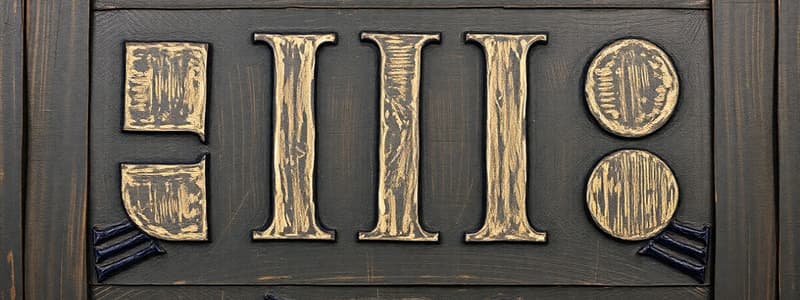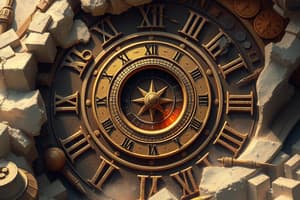Podcast
Questions and Answers
In what way does the Roman numeral 'III' contribute to early education?
In what way does the Roman numeral 'III' contribute to early education?
- It demonstrates advanced calculus principles.
- It explains the concept of negative numbers.
- It reinforces the concept of cardinality. (correct)
- It introduces complex algebraic equations.
How does the Roman numeral 'III' relate to the broader Roman numeral system?
How does the Roman numeral 'III' relate to the broader Roman numeral system?
- It is frequently used alongside I, II, IV, and V to represent a series of numbers. (correct)
- It is rarely used in conjunction with other numerals.
- It is the largest and most complex numeral.
- It is used as the basis for fractional calculations.
What aspect of ancient Roman culture is promoted through the continued use of the Roman numeral 'III'?
What aspect of ancient Roman culture is promoted through the continued use of the Roman numeral 'III'?
- The complex political structures of the Senate.
- Their advanced engineering techniques.
- Cross-cultural understanding. (correct)
- Their sophisticated legal system.
How does understanding the Roman numeral 'III' enhance mathematical literacy?
How does understanding the Roman numeral 'III' enhance mathematical literacy?
What does the simplicity of the Roman numeral 'III' exemplify about Roman numerals in general?
What does the simplicity of the Roman numeral 'III' exemplify about Roman numerals in general?
In practical terms, how does using Roman numeral 'III' benefit modern notation systems?
In practical terms, how does using Roman numeral 'III' benefit modern notation systems?
How does studying the Roman numeral 'III' benefit learners from an educational viewpoint?
How does studying the Roman numeral 'III' benefit learners from an educational viewpoint?
What primary mathematical principle does the Roman numeral 'III' signify?
What primary mathematical principle does the Roman numeral 'III' signify?
In the Roman numeral system, how does the numeral 'III' exemplify the system's core principles?
In the Roman numeral system, how does the numeral 'III' exemplify the system's core principles?
Beyond basic arithmetic, in what context is the Roman numeral 'III' commonly used?
Beyond basic arithmetic, in what context is the Roman numeral 'III' commonly used?
Which statement accurately describes the relevance of the Roman numeral 'III' in modern contexts, despite the prevalence of Arabic numerals?
Which statement accurately describes the relevance of the Roman numeral 'III' in modern contexts, despite the prevalence of Arabic numerals?
How does the understanding of 'III' as a Roman numeral contribute to grasping larger numbers within the same system?
How does the understanding of 'III' as a Roman numeral contribute to grasping larger numbers within the same system?
In what way does the Roman numeral 'III' reflect a 'cultural legacy'?
In what way does the Roman numeral 'III' reflect a 'cultural legacy'?
Which scenario best demonstrates how the numeral 'III' is applied beyond basic numbering to convey additional meaning?
Which scenario best demonstrates how the numeral 'III' is applied beyond basic numbering to convey additional meaning?
How might the visual characteristic of the numeral 'III' contribute to its effectiveness?
How might the visual characteristic of the numeral 'III' contribute to its effectiveness?
Considering that Roman numerals are still taught in elementary education, what primary understanding does learning 'III' impart to students?
Considering that Roman numerals are still taught in elementary education, what primary understanding does learning 'III' impart to students?
Flashcards
Roman Numeral 'III'
Roman Numeral 'III'
The Roman numeral 'III' represents the number three.
Additive Numeral System
Additive Numeral System
A numeral system where the values of numerals are added to find the total value.
'III' in Lists/Outlines
'III' in Lists/Outlines
In lists or outlines, 'III' often denotes the third item.
Roman Numerals in Books
Roman Numerals in Books
Signup and view all the flashcards
'III' on Clock Faces
'III' on Clock Faces
Signup and view all the flashcards
Volume III
Volume III
Signup and view all the flashcards
Regnal Numbers
Regnal Numbers
Signup and view all the flashcards
Sporting Event Editions
Sporting Event Editions
Signup and view all the flashcards
Usage of 'III'
Usage of 'III'
Signup and view all the flashcards
Cardinality
Cardinality
Signup and view all the flashcards
Historical Context of III
Historical Context of III
Signup and view all the flashcards
Non-positional System
Non-positional System
Signup and view all the flashcards
Numeral System Evolution
Numeral System Evolution
Signup and view all the flashcards
Contemporary Relevance
Contemporary Relevance
Signup and view all the flashcards
III - abstract and concrete
III - abstract and concrete
Signup and view all the flashcards
Study Notes
- The Roman numeral III represents the number 3.
- It is formed by combining three instances of the Roman numeral I, which represents 1
- The Roman numeral system is an additive system, meaning the values of the numerals are added together.
- Therefore, III = 1 + 1 + 1 = 3.
- It is a basic numeral used to represent the quantity three in contexts employing Roman numerals.
- The numeral is commonly used in outlines or lists to denote the third item.
- It can also be used to number pages in introductory sections of books.
- III appears on clock faces with Roman numerals, representing the number three.
- It is simple to construct and easily recognizable.
- The use of III is less common in modern mathematics, where Arabic numerals are preferred.
- However, it remains pertinent for cultural and historical reasons.
- It can be used to express volumes or parts of a series, such as Volume III of a book series.
- It is one of the first numerals learned when studying the Roman numeral system.
- It is used to represent regnal numbers of monarchs in some European countries.
- The numeral also finds applications in the names of sporting events, such as the third edition of a competition.
- The numeral retains significance in branding and design, conveying a sense of tradition.
- It is often used in conjunction with other Roman numerals to represent larger numbers like 13 (XIII) or 23 (XXIII).
- It serves as a base for the understanding of larger quantities in Roman numerals.
- The simplicity of III makes it straightforward to teach and learn.
- It is considered a fundamental building block in the Roman numeral system.
- It is still taught in elementary education to introduce students to the Roman numeral system.
- Its symmetry and balance may be factors in its aesthetic appeal.
- It represents not only a number but also a historical numbering System.
- It is used to denote triads or the third item in a defined set.
- The numeral demonstrates how repetition denotes addition in Roman numerals.
- It provides an easily understood example of the additive qualities within the Roman numeral system.
- It is easily transcribed or converted into cardinal numbers.
- It represents a cultural legacy of Roman numerals.
- It serves as a tangible link to ancient Roman civilization.
- It appears in many historical texts, documents, and inscriptions.
- It exemplifies the minimalist representation possible within Roman numerals.
- The numeral is easily distinguishable from other numerals.
- It is visually unique among smaller quantity Roman numerals.
- This makes it convenient for identification in text and illustrations.
- It is one of the more common numerals encountered in everyday life.
- It represents a small, but important, part of the Roman numeral system.
- The inclusion of III in early education reinforces the concept of cardinality.
- It is frequently used alongside I, II, IV, and V to represent a series of numbers.
- Its usage across various disciplines demonstrates the pervasive legacy of Roman numerals.
- It can symbolize a sequential ordering within a series.
- This is particularly useful in outlines or numbered lists.
- The numeral provides an element of historical context to modern notation.
- It is easily rendered using typewriters or early printing technology.
- It requires only the repeated use of the letter 'I'.
- It exemplifies the simplicity that made Roman numerals accessible to a wide audience.
- It promotes cross-cultural understanding by referencing ancient Roman customs.
- The numeral adds a sense of tradition and heritage to modern design.
- It demonstrates how numerical systems have evolved over time and cultures.
- It serves as a window into the mathematical understanding of civilizations.
- Its simplicity is a testament to the ingenuity of Roman scholars.
- The numeral is used to count sets of three items.
- It provides a way to express multiplicity in both abstract and concrete contexts.
- This makes it an important part of mathematical literacy.
- It exemplifies clear and concise notation.
- Its continued usage is evidence of the enduring influence of Roman culture.
- Roman numeral III remains familiar today.
- Its form and value persist in diverse fields.
- Understanding Roman numeral III offers insights into numerical systems.
- It demonstrates both the benefits and limitations of a non-positional system.
- This understanding improves appreciation for evolution in mathematical notation.
- Roman numeral III presents opportunities for educational exploration.
- It connects learners to significant aspects of cultural and mathematic history.
- It showcases how concepts were represented mathematically long ago.
- Roman numeral III maintains an active, symbolic role.
- Its form signifies historic links to ancient civilizations.
- Its function represents essential mathematical principles that persist to this day.
Studying That Suits You
Use AI to generate personalized quizzes and flashcards to suit your learning preferences.
Description
The Roman numeral III represents the number 3, formed by adding three instances of the numeral I (1+1+1=3). It's used in outlines, clock faces, and book introductions. While less common in modern mathematics, it remains culturally significant.




